Digital Eye Strain Monitoring for One-Hour Smartphone Engagement Through Eye Activity Measurement System
Highlights
- Portable system tracks eye fatigue during 1-hour smartphone use.
- Blink rate decreases while inter-blink interval increases over time.
- Social media content causes greater pupil fluctuations than reading or watching a video.
- Visual fatigue is linked to screen brightness and dynamic visual content.
- The system offers a low-cost tool for real-time eye strain monitoring.
Abstract
1. Introduction
2. Materials and Methods
2.1. Experimental Methods and Tools
2.2. Image Processing Techniques
2.3. Measurement of Eye Parameters
2.4. Questionnaire Assessment
2.5. Procedure for Selection of Participants
2.6. Experimental Procedure and Setup
2.7. Analysis of Data
3. Results and Discussions
4. Limitations and Future Scope
5. Conclusions
Author Contributions
Funding
Institutional Review Board Statement
Informed Consent Statement
Data Availability Statement
Conflicts of Interest
Abbreviations
| EAR | Eye aspect ratio |
| EOG | Electrooculogram |
| IR | Infrared |
| OpenCV | Open source computer vision |
References
- Milasevic, M. Digital Living: Who Are the Next Billion Internet Users? Available online: https://www.euromonitor.com/article/digital-living-who-are-the-next-billion-internet-users (accessed on 14 July 2025).
- Petrosyan, A. Worldwide Digital Population 2024. Available online: https://www.statista.com/statistics/617136/digital-population-worldwide/ (accessed on 14 July 2025).
- Petrosyan, A. Global Number of Internet Users 2005–2023. Available online: https://www.statista.com/statistics/273018/number-of-internet-usersworldwide/ (accessed on 14 July 2025).
- Reportal, D. Digital Around the World. Available online: https://datareportal.com/global-digital-overview (accessed on 14 July 2025).
- Kemp, S. Digital 2023: India. Available online: https://datareportal.com/reports/digital-2023-india (accessed on 14 July 2025).
- Tapanya, W.; Puntumetakul, R.; Neubert, M.S.; Hunsawong, T.; Boucaut, R. Ergonomic arm support prototype device for smartphone users reduces neck and shoulder musculoskeletal loading and fatigue. Appl. Ergon. 2021, 95, 103458. [Google Scholar] [CrossRef] [PubMed]
- Priya, D.B.; Subramaniyam, M. Fatigue due to smartphone use? Investigating research trends and methods for analysing fatigue caused by extensive smartphone usage: A review. Work 2022, 72, 637–650. [Google Scholar] [CrossRef] [PubMed]
- Dandumahanti, B.P.; Subramaniyam, M. Influence of smartphone game play on head flexion angle, muscle activity, and load at C7 among adolescents. Work 2023, 75, 1413–1425. [Google Scholar] [CrossRef] [PubMed]
- Dandumahanti, B.P.; Subramaniyam, M. Ergonomic evaluation of upper extremities muscle activity pattern during 60-min smartphone texting. Work 2024, 78, 477–488. [Google Scholar] [CrossRef]
- Beaven, C.; Ekström, J. A Comparison of Blue Light and Caffeine Effects on Cognitive Function and Alertness in Humans. PLoS ONE 2013, 8, e76707. [Google Scholar] [CrossRef]
- Wibirama, S.; Nugroho, H.A. Towards understanding addiction factors of mobile devices: An eye tracking study on effect of screen size. In Proceedings of the 2017 39th Annual International Conference of the IEEE Engineering in Medicine and Biology Society (EMBC), Jeju, Republic of Korea, 11–15 July 2017; pp. 2454–2457. [Google Scholar]
- Wang, Y.; Zhai, G.; Zhou, S.; Chen, S.; Min, X.; Gao, Z.; Hu, M. Eye Fatigue Assessment Using Unobtrusive Eye Tracker. IEEE Access 2018, 6, 55948–55962. [Google Scholar] [CrossRef]
- Zhang, C.; Wu, X.; Zhang, L.; He, X.; Lv, Z. Simultaneous detection of blink and heart rate using multi-channel ICA from smart phone videos. Biomed. Signal Process. Control 2017, 33, 189–200. [Google Scholar] [CrossRef]
- Sheppard, A.; Wolffsohn, J. Digital eye strain: Prevalence, measurement and amelioration. BMJ Open Ophthalmol. 2018, 3, e000146. [Google Scholar] [CrossRef]
- Sharmila, T.S.; Srinivasan, R.; Nagarajan, K.; Athithya, S. Eye blink detection using back ground subtraction and gradient-based corner detection for preventing CVS. Procedia Comput. Sci. 2019, 165, 781–789. [Google Scholar] [CrossRef]
- Chidi-Egboka, N.C.; Jalbert, I.; Golebiowski, B. Smartphone gaming induces dry eye symptoms and reduces blinking in school-aged children. Eye 2023, 37, 1342–1349. [Google Scholar] [CrossRef]
- Shi, X.; Qu, X.; Mi, W.; Chang, D. Study on index of visual fatigue of VDT work. In Proceedings of the 2011 IEEE 2nd International Conference on Computing, Control and Industrial Engineering, Wuhan, China, 20–21 August 2011; pp. 9–12. [Google Scholar]
- Oner, M. Measure of Visual Fatigue as a Link Between Visual Environment and Visual and Non-Visual Functions of VDT Users a Review on What We have and What We Need. In Proceedings of the 2018 IEEE International Conference on Environment and Electrical Engineering and 2018 IEEE Industrial and Commercial Power Systems Europe (EEEIC/I&CPS Europe), Palermo, Italy, 12–15 June 2018; pp. 1–6. [Google Scholar]
- Toh, S.H.; Howie, E.; Coenen, P.; Straker, L. “From the moment I wake up I will use it…every day, very hour”: A qualitative study on the patterns of adolescent’ mobile touch screen device use from adolescent and parent perspectives. BMC Pediatr. 2019, 19, 30. [Google Scholar] [CrossRef]
- Dandumahanti, B.P.; Subramaniyam, M. Biomechanical analysis of cervical spine (C2–C7) at different flexed postures. Int. J. Artif. Organs 2024, 47, 205–211. [Google Scholar] [CrossRef] [PubMed]
- Exelmans, L.; Bulck, J.v.d. Bedtime mobile phone use and sleep in adults. Soc. Sci. Med. 2016, 148, 93–101. [Google Scholar] [CrossRef] [PubMed]
- Leo, M.; Cazzato, D.; De Marco, T.; Distante, C. Unsupervised approach for the accurate localization of the pupils in near-frontal facial images. J. Electron. Imaging 2013, 22, 033033. [Google Scholar] [CrossRef]
- Nguyen, D.-L.; Putro, M.D.; Jo, K.-H. Lightweight CNN-based driver eye status surveillance for smart vehicles. IEEE Trans. Ind. Inform. 2023, 20, 3154–3162. [Google Scholar] [CrossRef]
- Balhara, Y.P.S.; Doric, A.; Stevanovic, D.; Knez, R.; Singh, S.; Chowdhury, M.R.R.; Kafali, H.Y.; Sharma, P.; Vally, Z.; Vu, T.V. Correlates of Problematic Internet Use among college and university students in eight countries: An international cross-sectional study. Asian J. Psychiatry 2019, 45, 113–120. [Google Scholar] [CrossRef]
- Balhara, Y.; Harshwardhan, M.; Kumar, R.; Singh, S. Extent and pattern of problematic internet use among school students from Delhi: Findings from the cyber awareness programme. Asian J. Psychiatry 2018, 34, 38–42. [Google Scholar] [CrossRef]
- Wibneh, A.; Singh, A.K.; Karmakar, S. Anthropometric measurement and comparative analysis of Ethiopian army personnel across age, ethnicity, and nationality. Def. Sci. J. 2020, 70, 383–396. [Google Scholar] [CrossRef]
- Cech, J.; Soukupova, T. Real-Time Eye Blink Detection Using Facial Landmarks; Czech Technical University in Prague: Prague, Czechia, 2016; pp. 1–8. [Google Scholar]
- Gao, Y.; Li, A.; Zhu, T.; Liu, X. How smartphone usage correlates with social anxiety and loneliness. PeerJ 2016, 4, e2197. [Google Scholar] [CrossRef]
- Alhassan, A.A.; Alqadhib, E.M.; Taha, N.W.; Alahmari, R.A.; Salam, M.; Almutairi, A.F. The relationship between addiction to smartphone usage and depression among adults: A cross sectional study. BMC Psychiatry 2018, 18, 148. [Google Scholar] [CrossRef]
- Balhara, Y.P.; Anwar, N. BehavioR: A digital platform for prevention and management of behavioural addictions. WHO South East Asia J. Public Health 2019, 8, 101–103. [Google Scholar] [CrossRef]
- Radwan, N.L.; Ibrahim, M.M.; Mahmoud, W.S.E.-D. Evaluating hand performance and strength in children with high rates of smartphone usage: An observational study. J. Phys. Ther. Sci. 2020, 32, 65–71. [Google Scholar] [CrossRef]
- Prakash, A.; Sharma, S.; Sharma, N. A compact-sized surface EMG sensor for myoelectric hand prosthesis. Biomed. Eng. Lett. 2019, 9, 467–479. [Google Scholar] [CrossRef]
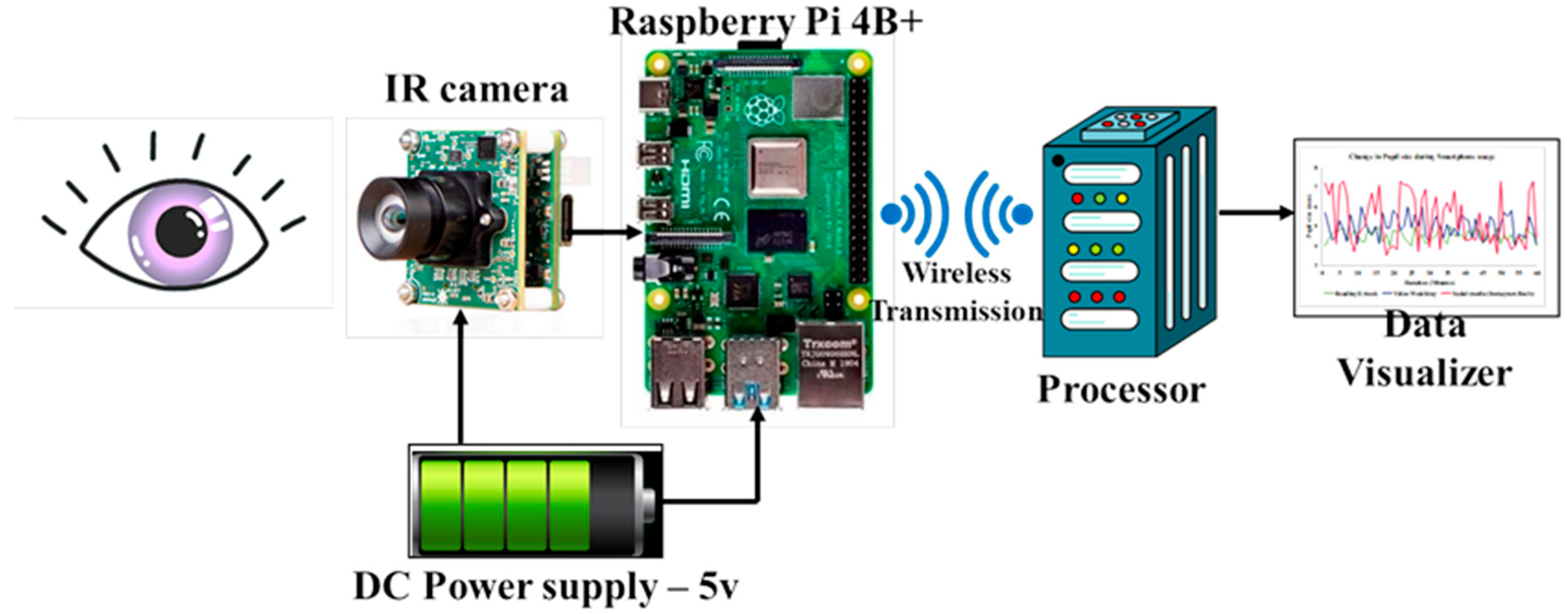
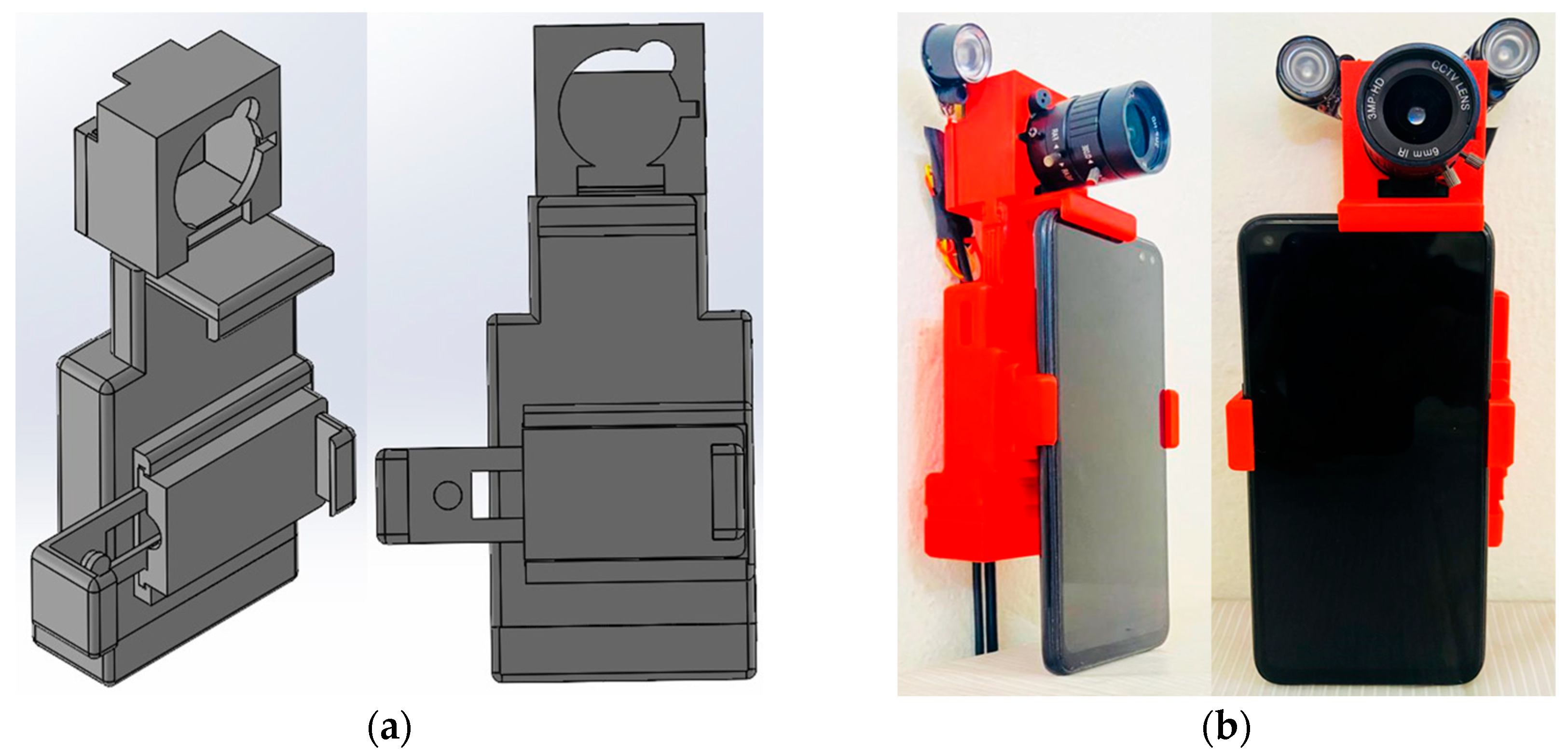

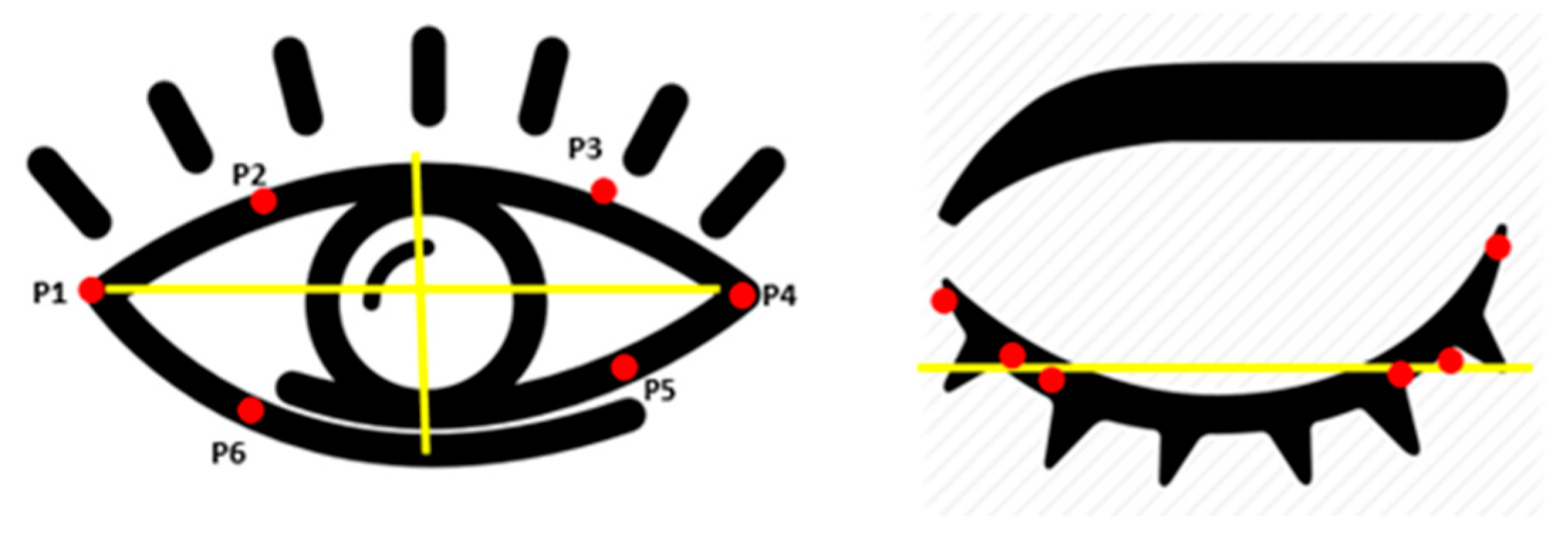
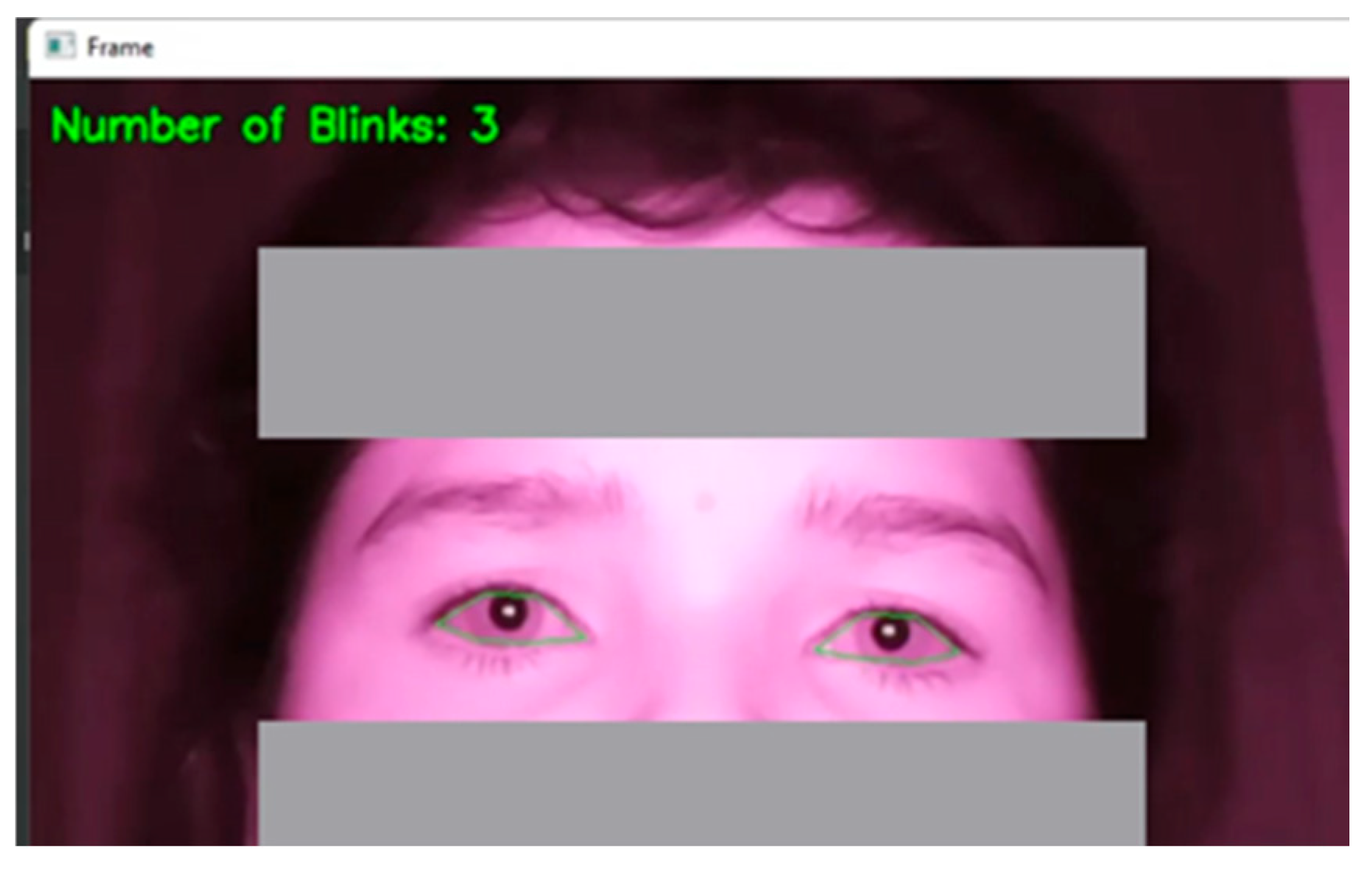
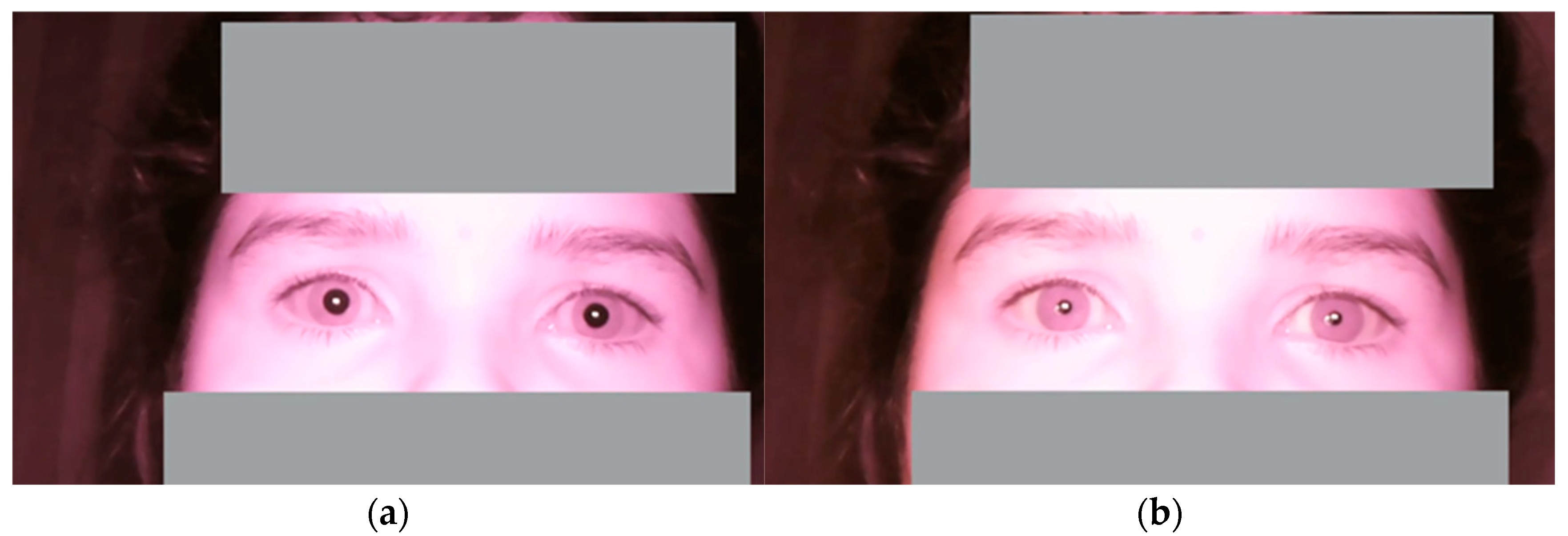
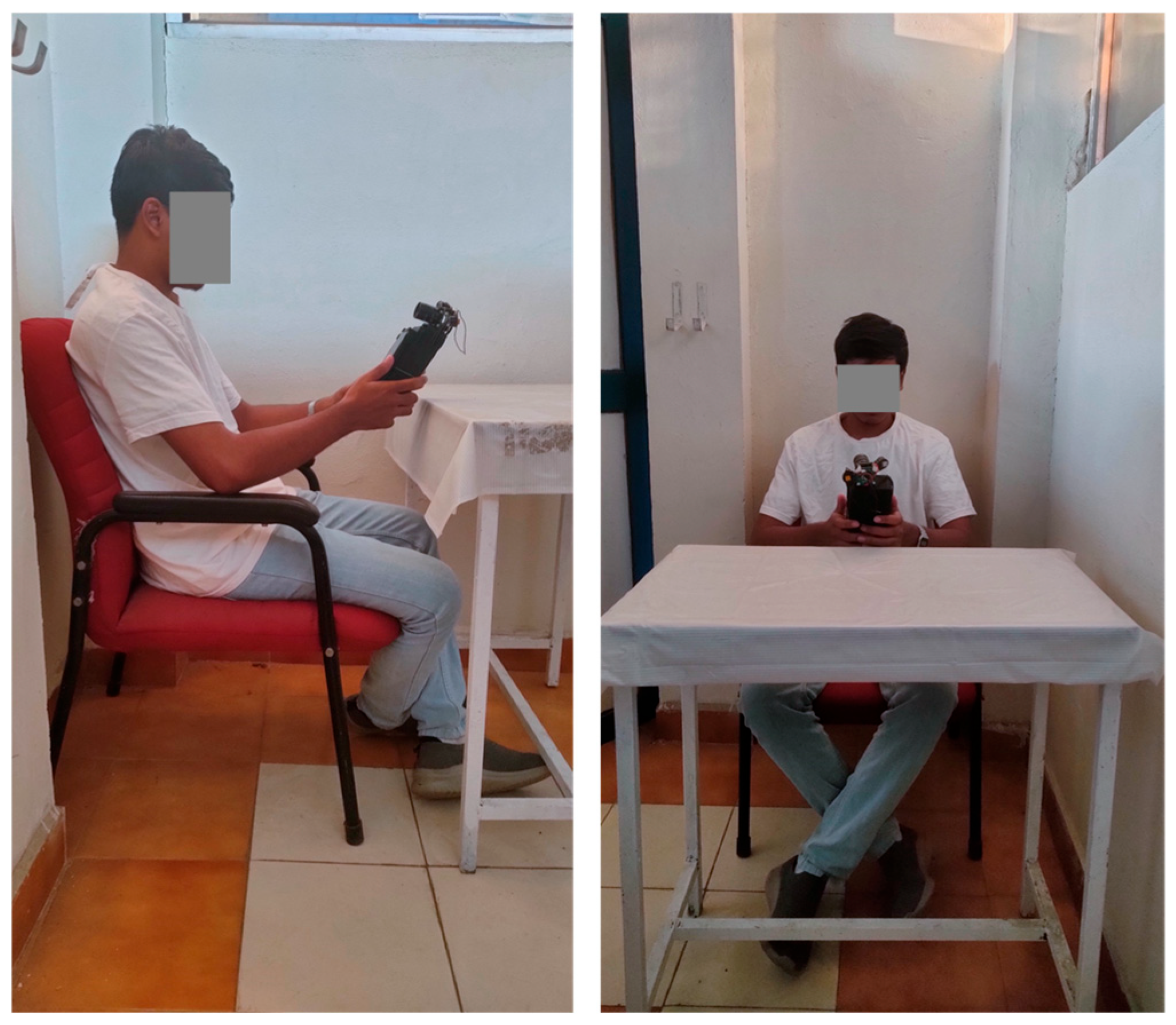
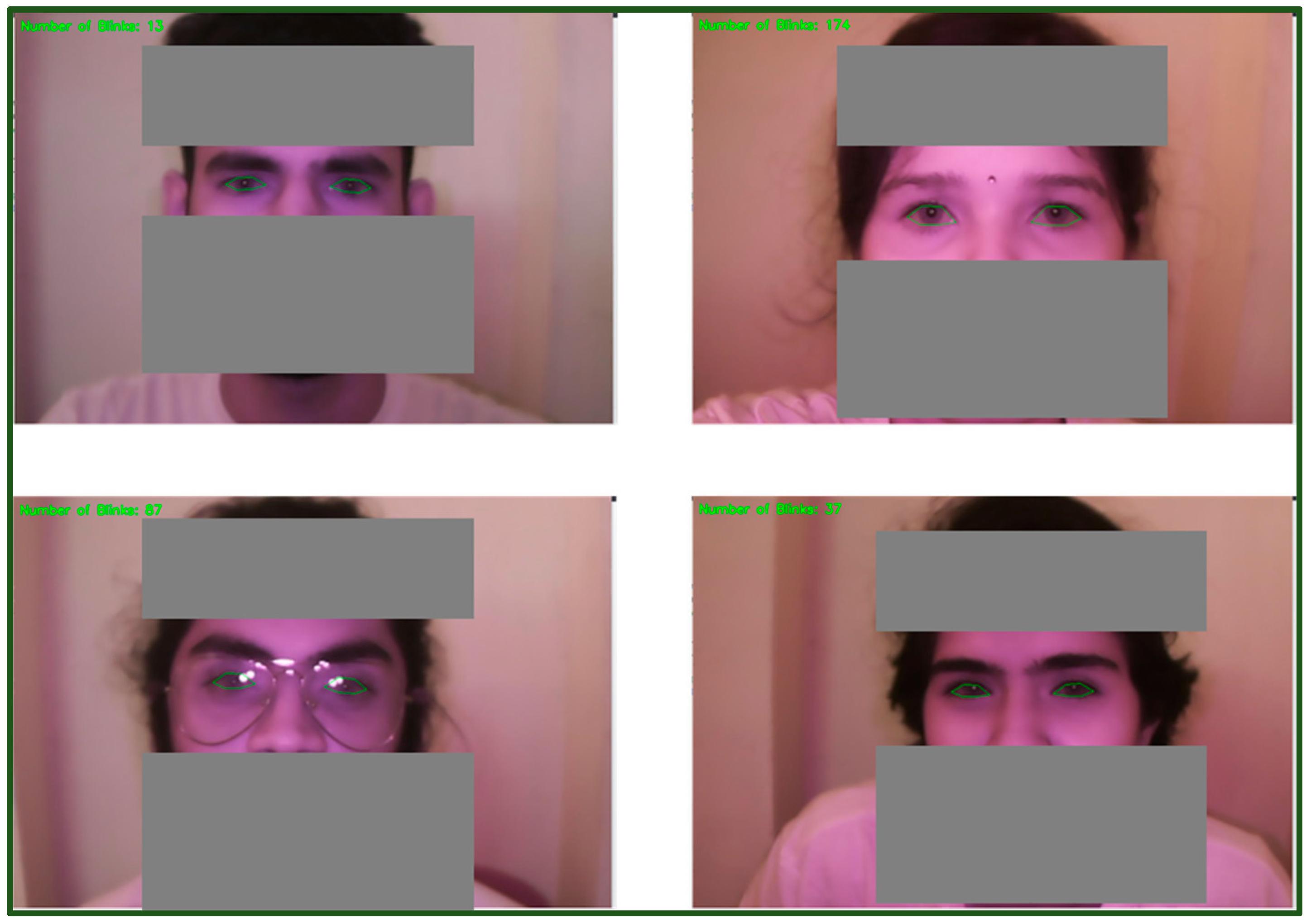


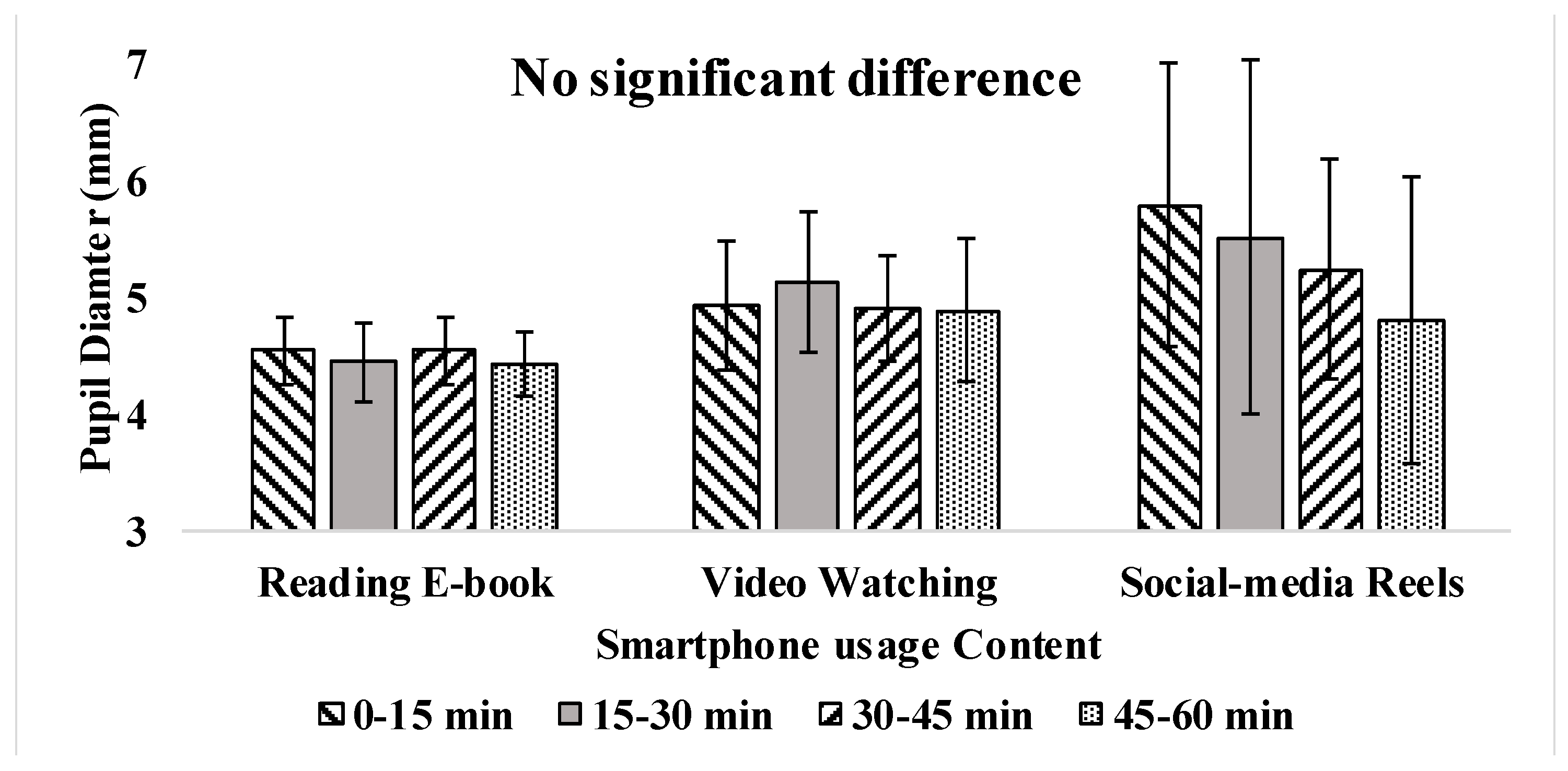
| Parameters | Participants’ Data (M ± SD) |
|---|---|
| Age (years) | 22.63 ± 2.83 |
| Gender | Male = 18; Female = 12 |
| Height (cm) | 168.83 ± 6.62 |
| Weight (kg) | 71.78 ± 8.92 |
| Eyesight (proportion) | Glasses = 68%; No Glasses = 32% |
| Familiarity with smartphones | >1 year |
| Usage of Smartphone (h/day) | 5.31 ± 1.72 h |
| Factors | Effect–Duration | M ± SD | Effect of Duration | Effect Size | Pairwise Comparison |
|---|---|---|---|---|---|
| Blink rate (blinks/min) | 0–15 min | 17.33 ± 1.32 | F = 49.98, p = 0.014 | ε = 0.250; η2 = 0.965 | Significant Difference (Steady Decrease) |
| 15–30 min | 14.26 ± 2.01 | ||||
| 30–45 min | 12.35 ± 1.86 | ||||
| 45–60 min | 10.58 ± 1.35 | ||||
| Inter-blink interval (s) | 0–15 min | 3.15 ± 1.62 | F = 89.98, p = 0.031 | ε = 0.457; η2 = 0.838 | Significant Difference (Steady Increase) |
| 15–30 min | 4.56 ± 1.23 | ||||
| 30–45 min | 5.94 ± 2.02 | ||||
| 45–60 min | 6.02 ± 1.43 | ||||
| Pupil dilation (mm) | 0–15 min | 4.35 ± 1.62 | F = 1.298, p = 0.219 | ε = 0.923; η2 = 0.028 | No Significant Difference |
| 15–30 min | 4.82 ± 2.02 | ||||
| 30–45 min | 5.14 ± 1.93 | ||||
| 45–60 min | 4.92 ± 1.64 |
| Factors | Effect– Content Type | M ± SD | Effect of Content Type | Effect Size | Pairwise Comparison |
|---|---|---|---|---|---|
| Blink rate (blinks/min) | E-book | 13.58 ± 2.63 | F = 1.74 p = 0.194 | ε = 0.927; η2 = 0.01 | No Significant Difference |
| Video | 12.35 ± 1.86 | ||||
| Social media | 13.33 ± 1.78 | ||||
| Inter-blink interval (s) | E-book | 3.76 ± 1.23 | F = 1.62 p = 0.185 | ε = 0.894; η2 = 0.03 | No Significant Difference |
| Video | 4.67 ± 1.61 | ||||
| Social media | 3.97 ± 2.98 | ||||
| Pupil dilation (min) | E-book | 4.23 ± 1.02 | F = 1.26 p = 0.179 | ε = 0.963; η2 = 0.03 | No Significant Difference |
| Video | 4.36 ± 1.19 | ||||
| Social media | 5.14 ± 2.48 |
Disclaimer/Publisher’s Note: The statements, opinions and data contained in all publications are solely those of the individual author(s) and contributor(s) and not of MDPI and/or the editor(s). MDPI and/or the editor(s) disclaim responsibility for any injury to people or property resulting from any ideas, methods, instructions or products referred to in the content. |
© 2025 by the authors. Licensee MDPI, Basel, Switzerland. This article is an open access article distributed under the terms and conditions of the Creative Commons Attribution (CC BY) license (https://creativecommons.org/licenses/by/4.0/).
Share and Cite
Dandumahanti, B.P.; Chittoor, P.K.; Subramaniyam, M. Digital Eye Strain Monitoring for One-Hour Smartphone Engagement Through Eye Activity Measurement System. J. Eye Mov. Res. 2025, 18, 34. https://doi.org/10.3390/jemr18040034
Dandumahanti BP, Chittoor PK, Subramaniyam M. Digital Eye Strain Monitoring for One-Hour Smartphone Engagement Through Eye Activity Measurement System. Journal of Eye Movement Research. 2025; 18(4):34. https://doi.org/10.3390/jemr18040034
Chicago/Turabian StyleDandumahanti, Bhanu Priya, Prithvi Krishna Chittoor, and Murali Subramaniyam. 2025. "Digital Eye Strain Monitoring for One-Hour Smartphone Engagement Through Eye Activity Measurement System" Journal of Eye Movement Research 18, no. 4: 34. https://doi.org/10.3390/jemr18040034
APA StyleDandumahanti, B. P., Chittoor, P. K., & Subramaniyam, M. (2025). Digital Eye Strain Monitoring for One-Hour Smartphone Engagement Through Eye Activity Measurement System. Journal of Eye Movement Research, 18(4), 34. https://doi.org/10.3390/jemr18040034









